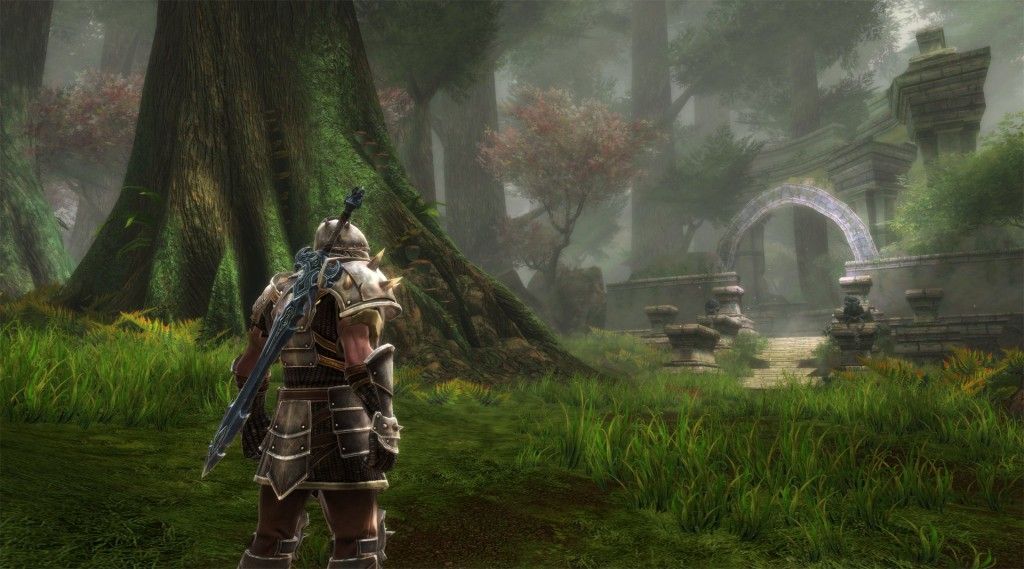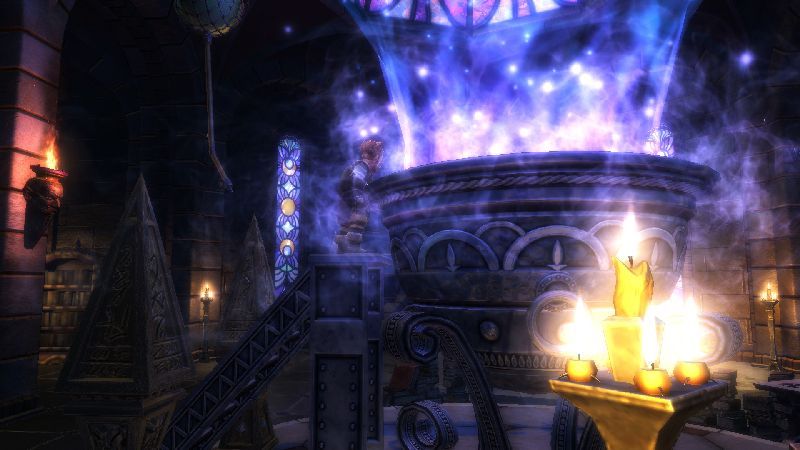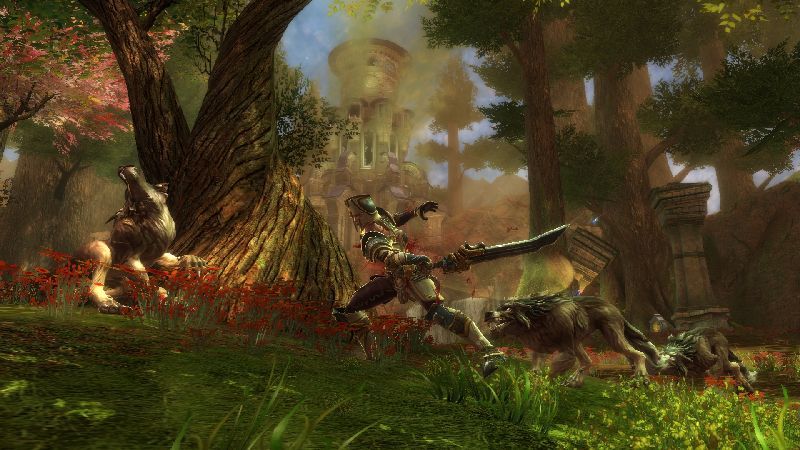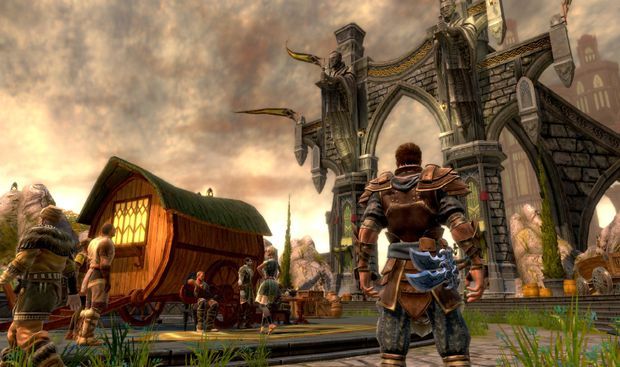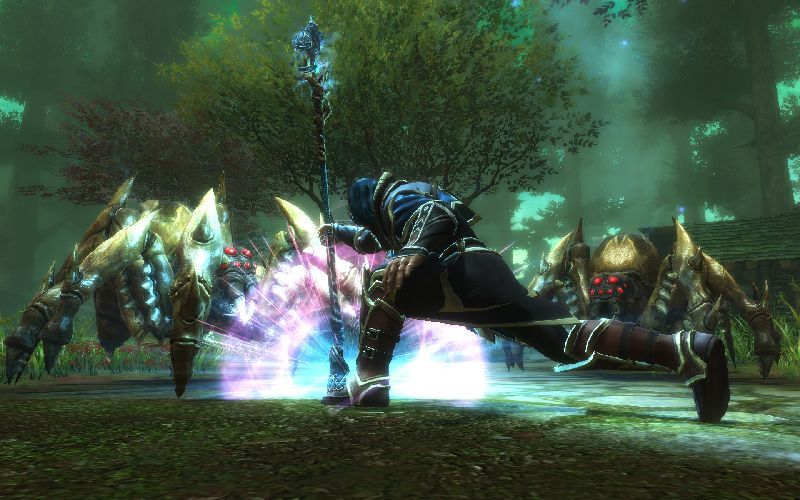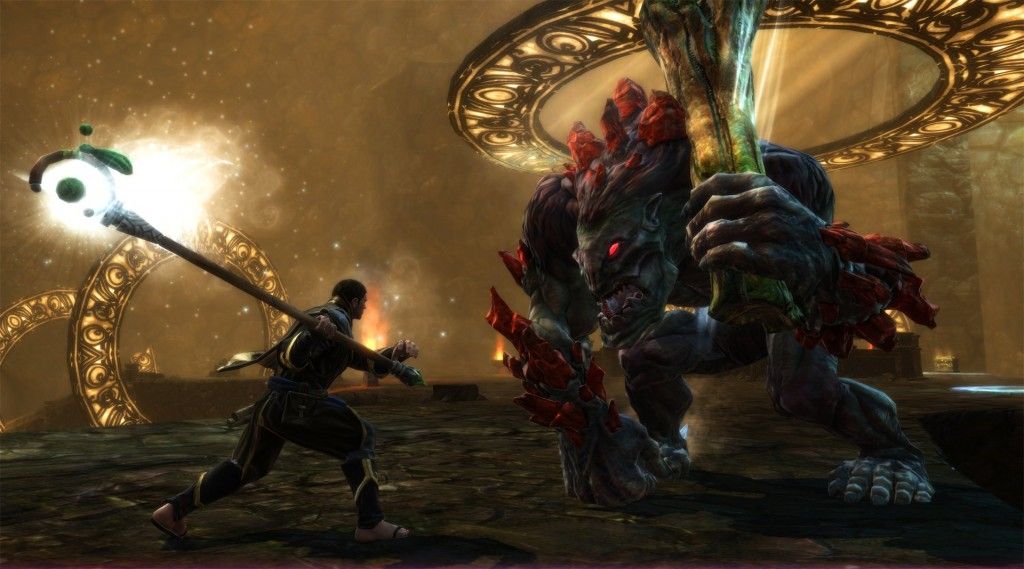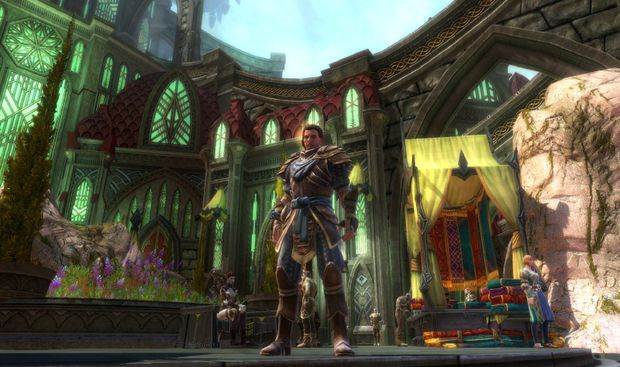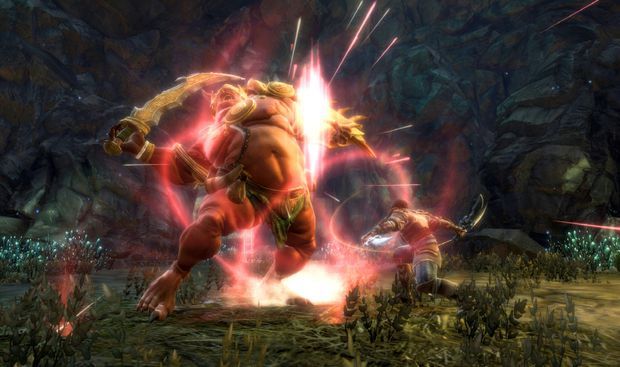One thing I’ve learned over the years of being a gamer is to manage your expectations. Developers rarely deliver the sometimes grandiose game features they promise and, even if they do, it’s delivered in a half-hearted or lackluster manner. Reading about and seeing Kingdoms of Amalur: Reckoning demoed over the last nine months or so on various occasions seemed to prepare me for the worst. It was promised to be everything I would personally want in a Western RPG, and I felt it was too good to be true; this game would never live up to the expectations the developers were setting for it.
Then I actually played it. That line of thinking quickly went out the window.
Kingdoms of Amalur: Reckoning is a game that does exactly what is advertised, and does it very, very well. It takes many of the things that tend to get left by the wayside in RPGs – things that, many times, players really want – and include them as if to say, “This is what an RPG should have been like all along.” It’s with this nonchalant attitude about these features and about the pure, unbridled fun and awesomeness you get that Reckoning pulls you into its world, its story, its people and its desire to be everything anyone could ever want in an RPG.
After a brief introduction, the game delivers you on the character creation screen, where you can choose one of four races, and design your character to your heart’s content. You are a dead man (or woman), and you are revived through a Gnomish invention called the Well of Souls. Nothing is known about your past other than the fact that you died – somehow. The entire game – both main story and the many side-quests you’ll encounter – aim to help you build your world again and, for all intents and purposes, start a new life.
After the tutorial dungeon, you’re deposited in a lush, gorgeous and colorful world filled with so many things to do it will feel like a major life decision to choose what to do first. The problem with the world, if you want to call it that, ironically leads to possibly its greatest strength. The world itself holds nothing new. It’s typical high fantasy. For those familiar with the genre, you likely won’t find anything here that will surprise or amaze you. However, in that perceived weakness lies the subtle pretext that, it seems, the design team simply didn’t want to create something new – they just wanted to create an awesome fantasy world.
That they did, as this is possibly one of the most gorgeous fantasy worlds I’ve seen in a game in quite a while. We’re hot off the heels of Skyrim, and many people are still attached to that world. However, Reckoning offers something different, yet familiar. It’s colorful and vibrant, while other fantasy worlds in similar RPGs seem to focus on more of an ominous and foreboding tone.
You won’t find as much life or persistent activities as a game like Skyrim, but that is offset by the sheer vibrancy of the world’s design, as well as the color saturation and lighting. All that combines to create something that could have come straight from a fairy tale. That is, until you discover just how brutal and unforgiving the world can be. While a large part of the first huge area you explore (which, itself, is split up into many sub-zones, or "bubbles" as I started calling them) is forest-like, each sub-zone has subtle differences that really stand out and make you realize you're somewhere different than you were just a few minutes before. Yes, some "bubbles" change drastically - such as going from an overgrown forest to an open plain with huge rocky crags jutting up out of the ground - but between others the change is an exquisite palate change that is inconspicuous, yet somehow "pops" off the screen in a huge array of colors.
The story itself is a bit predictable, but in different ways. What I also like is, although it isn’t massively branching in the vein of something like Mass Effect, it does allow you some freedom of choice throughout. If you follow the main story, at various points you’ll be given a choice of what to do next – go follow person A or go follow person B. Also, while fairly common fantasy fare, there are point in the story that get rather intense and chilling. It soars to epic heights at times, and at others retains its rather mundane exterior. This isn’t to say the mundane is bad, per se, but the best parts of the story are the few times you get that chill running through your spine and you realize that something epic is about to go down.
One of the selling points of Reckoning is its high amount of customization. Your character is referred to in-game as the “fateless one”, which sets a story precedent for the gameplay mechanic that allows you to switch up anything about your character whenever you want. For a nominal fee, you can release all your talent points and skills learned and reassign them to create an entirely different character. You can switch up weapons at will with no loss in proficiency aside from reassigning your skill points to be more in line with your new weapons of choice. Finally – and this is one thing many RPGs of this sort fail to include – you can make aesthetic changes to your character after you’re done with the initial character customization.
There are three types of combat proficiencies – Sorcery, Might and Finesse. Each of these attaches itself to a rather typical RPG trope – magic, warrior combat and thief/rogue respectively. While the talent trees for each can mix and match however you want, there are also other benefits to your combat arsenal. Fate cards (destinies) are designed to give you bonuses in your selected proficiencies. There are cards for just about every pure “class” and any mixture of classes you might want to be. You can mix Sorcery and Might, for example, and become a battle mage, able to wield a sword, but also able to beat your opponent into submission from a distance with magic. New fate cards open up as you put talent points into the three schools of combat and cards called “Twist of Fate” are granted after completing certain story or quest objectives.
The best part of upgrading your destiny is the subtle changes to your character itself. One I particularly enjoyed is, when you unlock the tier three sorcery destiny, called Seer, instead of rolling out of the way to dodge, you teleport. While this is simply a visual animation change, it really adds a lot to the characterization of your avatar and makes you feel like you’re really leaning in the direction of being a powerful magic wielder.
More customization comes in the form of passive bonuses. Each time you level up you get to upgrade one passive ability, which can be anything from the three crafting schools, to lock picking, to stealth. There is an endless variety of customizations you can make to your character – from both a visual and a stat-oriented viewpoint. This all works amazingly together to help you build the character YOU want to play, not one that is on a preconceived path that you must choose and stick to from character creation onward.
With all that customization, you’ll probably want to use your uber character to kick some enemies into next week, right? The combat in Reckoning is no slouch, either. While I was wandering around the Faelands, kept feeling a couple things wash over me as I participated in combat. The first was – this is so freaking cool! The second was that this is what happens when Fable and Monster Hunter have a love child. However, the new bundle of joy feels smoother than the combat in Fable and less monotonous than that in many Monster Hutner titles.
You have your choice of several weapons, including some unique entries such as the chakram, which was my magic-wielder’s weapon of choice. Each weapon – if you choose to develop it with talents – has many different attacks it can be used to perform, using a combination of buttons and game mechanics. It was always sadistically satisfying to end my flurry of chakram attacks by sending the deadly metal discs out to hit and enemy, and then they’d return to me, slicing into the enemy’s back one more time for good measure. Performing the uber area-of-effect attack with fiery chakrams is another huge ego boost for my character, as they cut and burn enemies to shreds with the sound of explosions resonating through the bass in my audio system.
Casting spells is also a glorious light show – everything from individual bursts of electricity to the fire bombs you can place on enemies and detonate at your very whim (yes, that is my favorite spell, how did you guess?). The flash and flair of combat is a sight to behold, and everything works very smoothly together. The animations flow into each other and the controls are very intuitive and tight, assigning one weapon to each face button. Your right shoulder button brings up your magic menu, which give you a total of four available magical abilities, while your left shoulder button whips out your equipped shield to block oncoming blows.
It isn’t just all about the glitz and glam of combat, though. The small things come through, as well. There’s a slight artistic panache in how the movements flow in combat. When you dodge, a very slight slow-down occurs which gives you a split-second feeling like you’re dodging bullets in the Matrix movies. As you wield your weapons, the same stylish visual pops litter the landscape of battle, which really makes for epic and satisfying combat, even when you’re fighting nothing but the most common of enemies.
Of special mention is your fate meter. While normal combat is rather epic in and of itself, when your fate meter fills through successful combat and shift into Reckoning Mode, you feel like a god. In this mode, your attacks gain strength and time slows down, allowing you to do massive damage to enemies around you. While in basic Reckoning Mode, you don’t kill enemies, you beat them to a sliver of their health. At this point, a prompt appears that will allow you to unleash a massive, scripted attack that completely obliterates any enemies that are in that state and gains you extra experience for the effort.
There are a few things that slightly bother me about combat, however. First off, it has the potential to get very button-mashy, especially for certain character builds (typically the melee variety). The developers do a great job of trying to offset this with a plethora of possible abilities and ways to customize your characters’ attack patterns, however it still bled out, no matter how hard I tried.
Secondly, and possibly of greater annoyance, in my personal opinion, is the fact that your health does not regenerate outside of combat. This leaves you endlessly consuming potions and wondering if you have enough in your inventory to make it through the dungeon you just entered. This is somewhat offset by healing abilities that you have to actively decide to spent points on.
Finally – and this is always an issue for me and seems prevalent in any action-style game throughout several genres – it bothers me greatly that, for some reason unbeknownst to me, I can’t dodge while I’m in mid-swing. When I fling my chakrams out at an enemy and it shrugs them off and comes at me, I want the ability to dodge instead of waiting for the attack animation to complete. This has led to more frustration than anything else, and is something that is persistent throughout the entire game. It artificially inflates the AI difficulty and is just straight up frustrating.
Those aside though, combat is a very fun and surprisingly visceral experience. While combat in other Western RPGs isn’t always bad, not one I’ve played in recent memory (including Skyrim) has had such a fun, engrossing and powerful combat experience.
The music and voice acting are fairly top notch, as well, although the soundtrack stands out above the actors. Sometimes I feel the voice acting, especially the accents, are forced. This causes them to feel fake and over-acted to the point of being overly melodramatic and that turns me off. However, generally speaking, the dialog is fun and can sometimes be surprising. I’m slightly disappointed that we have yet another silent protagonist in a Western RPG, however it doesn’t particularly take away much from the experience. It does feel a bit off-putting, considering there are other big-budget RPGs that include the full experience.
However, the decisions you can make to change the course of dialog add a voice to your character that you would otherwise not have. So, in a similar respect to Skyrim, the silent protagonist route isn’t necessarily a drawback.
The entire world of Amalur that you can explore in Reckoning, dubbed the Faelands, is simply infatuating. It’s breathtaking how deep the lore is for a game that is the first in the franchise. While playing through it, it honestly felt like the franchise had been around for years. The game is very polished and simply exudes fun at every turn.
Possibly the best compliment I can give Kingdoms of Amalur: Reckoning is that, nearly every time something came up that is included in this game that I didn’t expect – in-game character re-customization, player housing, full-fledged crafting systems, the ability to lump all junk in your inventory into one pile and sell it with one button press, etc. – I thought, “This RPG seriously has nearly everything I could want in a game of this sort. Rock on.” If that is what the guys at 38 Studios and Big Huge Games set out to do, they have succeeded in spades.
There may be a few issues here and there that would have elevated this game to “awesome legendary entry for a new IP” if they were included (sorry, I can’t get the lack of out of combat health regeneration out of my head), there is a lot of awesome content packed into this experience that will likely satisfy those looking for a reprieve from the world of other recent entries in the genre. Role playing fans should certainly focus their radars firmly in the direction of Kingdoms of Amalur: Reckoning, as it is a worthy entry in the genre and a franchise I hope to see in it for the long haul.


